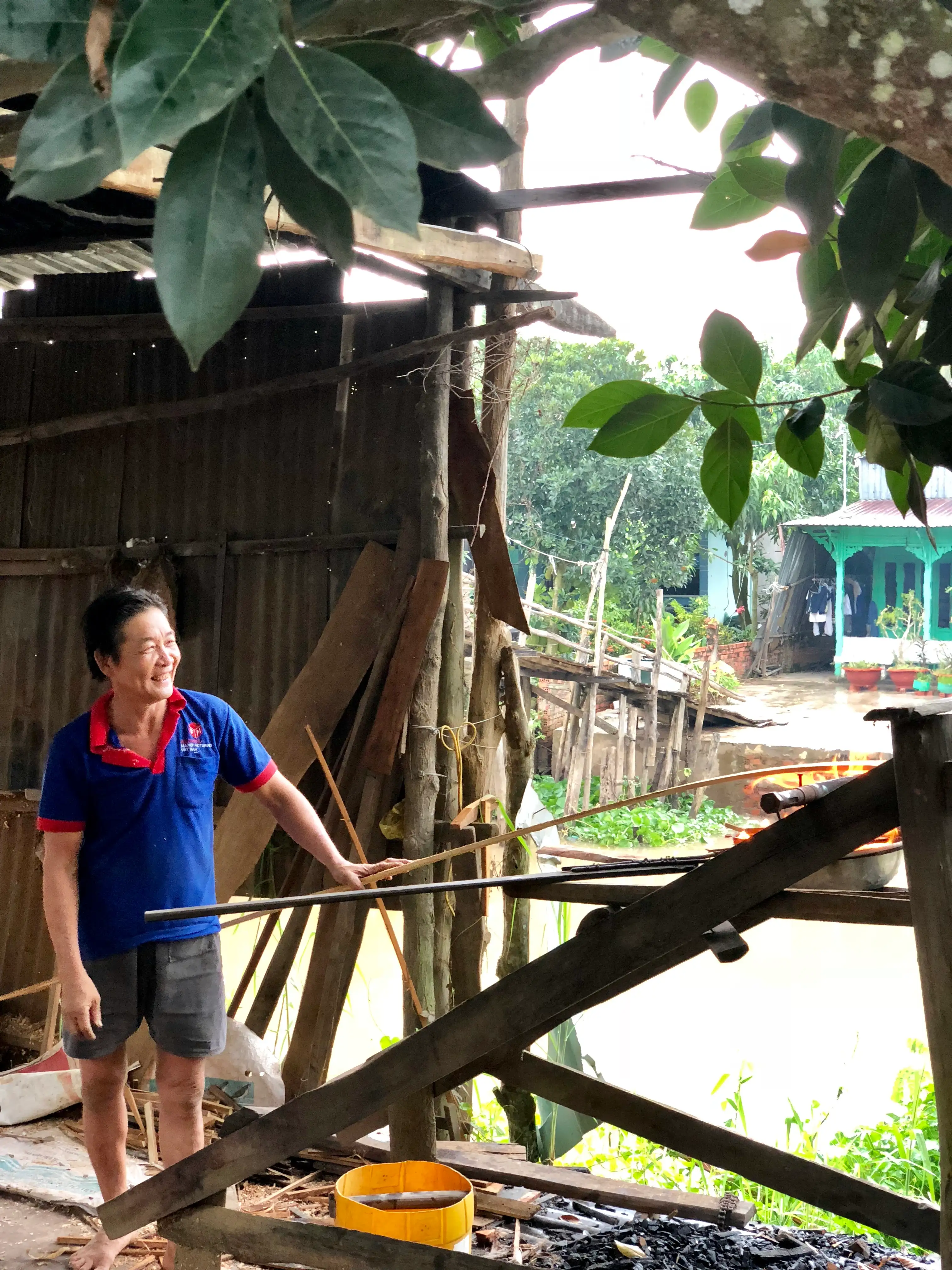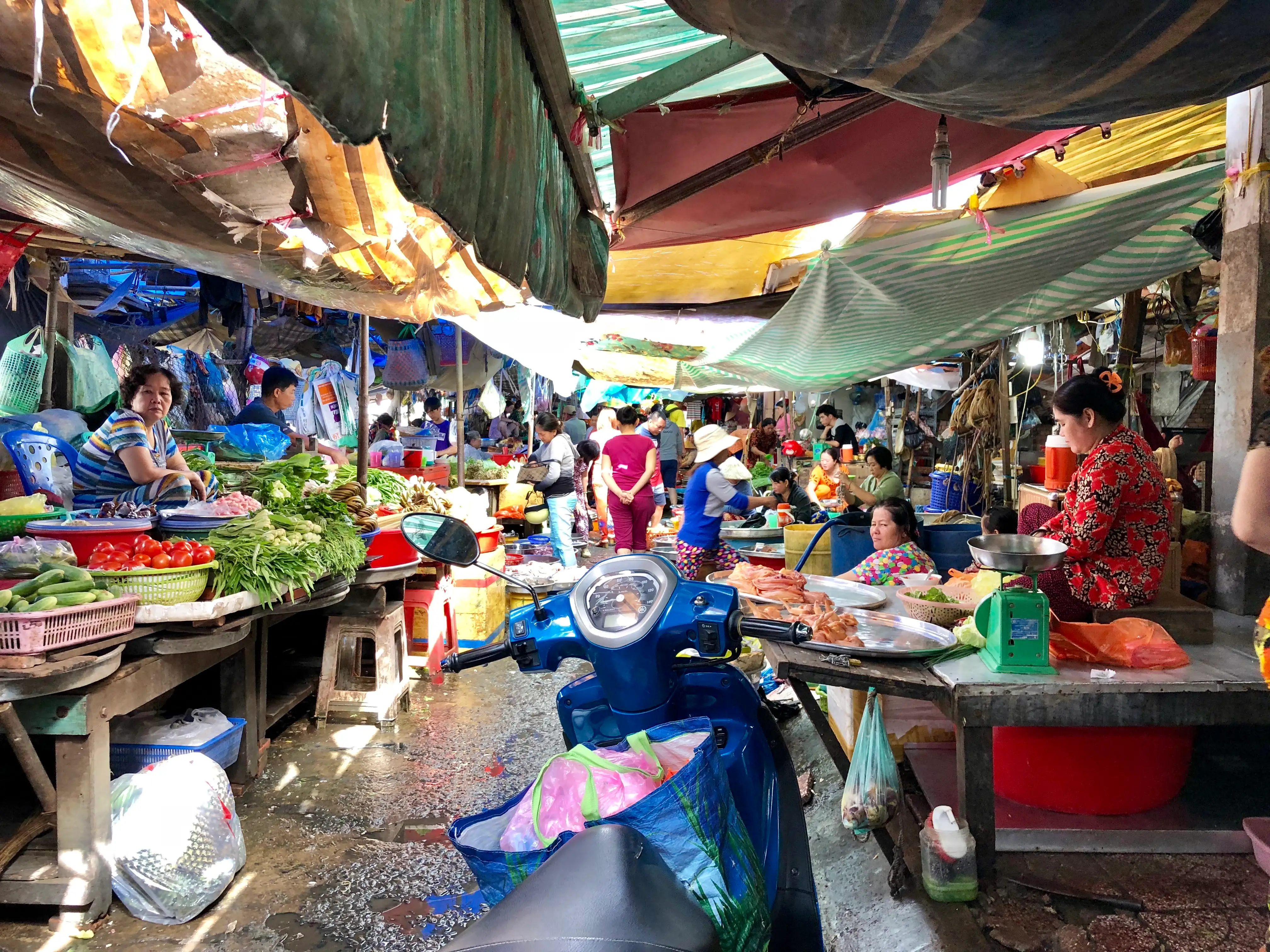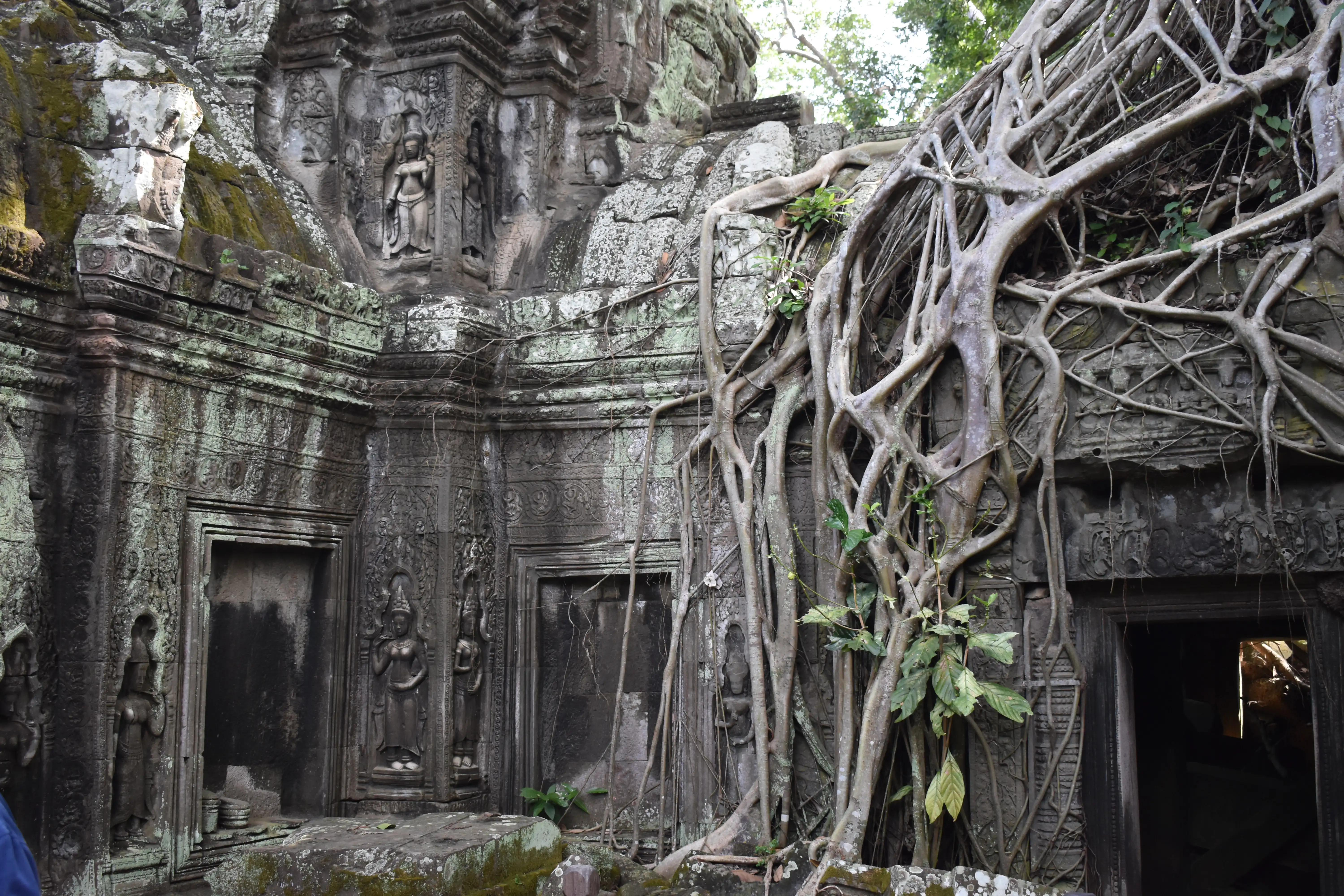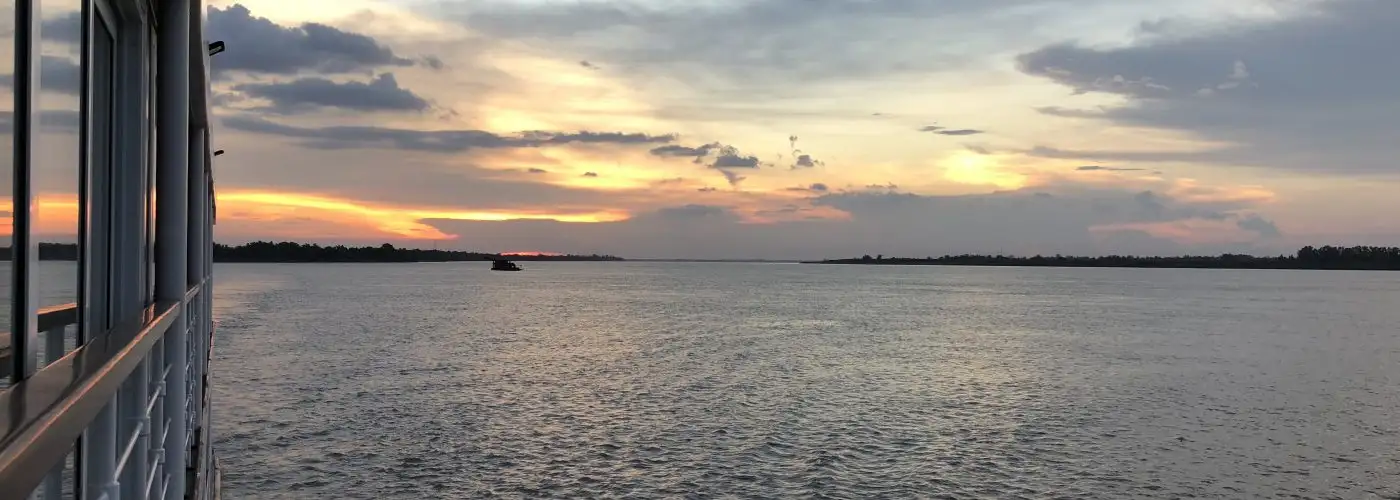In a small Cambodian village on the banks of the Mekong River, I walk a cobbled path that winds gently past houses on stilts and thickets of glossy-leaved trees. The small group I’m traveling with occasionally congregates to talk to locals through our guide, Virak, or our cruise director, Phiam. But mostly we just filter quietly one by one through this sleepy village in the afternoon heat, giving our best Cambodian hellos—“suasdey”— to the curious children and industrious grandmothers who are at home at this time of day. We walk by the shaded, open-air living spaces on the ground floors of their stilt houses, glancing for long enough to exchange hellos, but not so long as to stare. A few locals invite us in to their homes as we pass; I get a tour of a rural Cambodian kitchen and laugh with a child playing with a kitten.
There’s a zero percent chance I would have found this village on my own. It’s not in any guidebook, and it’s barely connected to the rest of the world by road. Even if I had somehow managed to find it independently, I would miss the richness of the experience for not being with Virak and Phiam. They’ve not only built relationships with this community, but also act as a language and cultural bridge that allow us to have actual conversations—complete with questions and joking banter—with the locals, whose lifestyle seems so different but whose warmth feels welcomingly familiar.
This is not what most people think about when they conjure up a mental image for the phrase “shore excursions.” There’s nary a bus sightseeing tour or a zip line in sight. And yet, it’s at the very heart of this Avalon Saigon sailing, which starts a few blocks from downtown Saigon and follows the Mekong River through Vietnam and into Cambodia before veering onto the Ton Le Sap River and into the Ton Le Sap lake to end its journey in Siem Reap, home to the bucket-list-darling Angkor Wat. The small ship—36 guests maximum in 18 staterooms—is the only cruise vessel to sail all the way between the two cities. Its modest proportions allow its passengers to explore these small villages in which there’s no port, just a sloping clay river bank.
Redefining the ‘Shore Excursion’
“We’re always looking for the right balance of truly authentic experiences,” says Ryan Droegemueller, Manager of Product Creation at Avalon, whose job it is to always be on the lookout for new, unique experiences along the Mekong. His regular scouting missions rely on a combination of advance research, local connections, and getting out on the river to look for thriving communities, engaging craftspeople, and experiences that are unique to life on the Mekong.
“We’re lucky we sail significantly more of the Mekong, because it gives us many more options,” he notes. “We wouldn’t want the excursions to be all temples, so we work hard to find local industries—for instance people making traditional hats, scarves, silver, or candy—that we can share with guests.”
Rather than charging passengers per shore excursion, all passengers have access to the two planned excursions each day, with plenty of free exploration time in the mix in the larger cities.
Keeping Itineraries Fresh
The itinerary on the Avalon Saigon—and its sister ship the Avalon Siem Reap—shifts each year. Sometimes that’s because other cruise lines or visitors get hip to a previously off-the-beaten-path spot that Avalon visits. Rather than contribute to a tourism inundation that may well change the nature of the place, Avalon often makes the decision to find another point of interest. Droegemueller recalls just such a scenario: “We used to visit a weaving village in Cambodia, but a competitor started visiting and it became popular with tourists from Phnom Penh, so we found a beautiful, small weaving village in Vietnam to visit instead.” His constant quest for authenticity serves the passengers of this small ship well.
Itinerary vs. Reality
Exceptional experiences can’t always be distilled into a quick description, though, and itineraries have a nearly impossible job: to convey these special experiences in just a few easily skimmed words. To bridge the divide between what the itinerary hints at and the nature of the actual experience, here are three dips into the great well of the carefully selected shore excursions offered on Avalon Mekong sailings.
Shore Excursion: The Sampan Maker

Itinerary Quote: “Stop at a local home, where a skilled family works together to hand-craft sampans for a living.”
The Experience: From the ship, we step across onto a smaller boat that ferries us across the wide Mekong into a peaceful backwater framed by trio of rickety wooden pedestrian bridges connecting the two sides of a tiny village. We stroll along a narrow dirt road, past a makeshift café with a few low plastic chairs occupied by a group of men clustered around steaming cups. Next door, three kids play in their doorway. I pause to peek into a shop selling vegetables, sweets, and gasoline; and move to the side of the road to allow a blink-and-you’ll-miss-it rush hour of three scooters heading down to the ferry that shuttles people, goods, and scooters to the Mekong’s far bank.
We arrive at the sampan maker’s workshop, a long, open-sided roofed house that hangs over the bank of the backwater. A half-finished boat is surrounded by wood scraps and curled shavings. In one corner, the sampan maker stands over an open flame, resting a long piece of wood over the fire, coaxing the board millimeter by millimeter into the curving shape of a hull. The air smells like rain, wood, and fire. The boat maker smiles as he talks to us but never stops working, keeping the wood over the flame as he listens to and answers questions from our Vietnamese guide and translator Nam.
Long after we leave, I continue to revisit this brief stop in my mind; after spending our first few days in the intense jumble of Ho Chi Minh City, this tranquil introduction to Vietnamese village life feels like a quiet revelation. It sets the tone for our further explorations into rural Vietnam and Cambodia.
Shore Excursion: The Wet Market

Itinerary Quote: “Walk through the local market and absorb the atmosphere as locals are busy buying and selling fish, meat, and produce.”
The Experience: As we enter the market full of narrow lanes shared by pedestrians and scooters, our group of about 20 people disperses, connected by our earpieces to the explanations and instructions of Nam, our guide through Vietnam, but each able to move at our own pace. It’s morning and breakfast is still in full swing at the pho stands flanking the market’s dense interior—shoppers vie for a spot at the counter as they slurp soup side by side. The uneven paved ground is wet from a recent rain and I dodge puddles and duck under the colorful tarps draped haphazardly across the market’s center aisle.
The flower sellers woo with intricate blooms and towering piles of brightly colored ripe fruit tempt passersby. As enticing as the rest of it is, the crowds of locals make it clear that the real reason people visit this market daily is the fresh river fish—catfish, minute carp, eel, and dozens of other species. Many of the fish are sold live—they swim and flop around in shallow metal trays bubbling with a constant stream of water. This isn’t a tourist market; we’re the only Westerners here and the locals are too busy socializing and shopping to pay us much mind. I walk slowly, grateful for the chance to linger and observe before plunging back out into the heat of the day.
Shore Excursion: The Bucket-List Ruins

Itinerary Quote: “Arrive in Siem Reap and start your sightseeing of the Temples of Angkor, considered by many to be the most spectacular architectural ruins on earth.”
The Experience: Though many of the excursions are to rural locales, this Mekong sailing is anchored by stops in three larger destinations: Ho Chi Minh City (Saigon), Phnom Penh, and Siem Reap. This last (or for people boarding the southbound route, first) stop takes guests off the ship and into a hotel for a multi-night stay that allows time to explore not just Angkor Wat—the most famous of the massive, famous temple complex—but other notable temples as well. Off-the-beaten-path Banteay Srei temple is smaller than Angkor Wat and famous for its intricately carved red sandstone structures; Ta Prohm is a fairytale mix of jungle and ruins; and Bayon Temple features 200 carved Buddha faces crowning 54 towers.
To visit the Temples of Angkor with a knowledgeable guide is to bring these spectacular ruins to life. There’s little signage at the temples, and while a guidebook offers context, a certified guide (guides must be certified specifically for Angkor to leads groups) can tell you the story around every corner and marry the ancient and recent histories for a more complete picture of this beautiful, complicated place.
And that, perhaps, is the key—these shore excursions embrace both the beauty and the complicated nature of Vietnam and Cambodia, not shortchanging either reality in a quest to tell an easy story of life along the Mekong.
More from SmarterTravel:
- 10 Dreamiest Barge Cruises in Europe
- 10 Hidden Places the World Doesn’t Know About
- 7 Most Beautiful Castles Outside Europe
Christine Sarkis visited Vietnam and Cambodia as a guest of Avalon River Cruises. Follow her on Twitter @ChristineSarkis and Instagram @postcartography for more advice about making every vacation the best vacation.
We hand-pick everything we recommend and select items through testing and reviews. Some products are sent to us free of charge with no incentive to offer a favorable review. We offer our unbiased opinions and do not accept compensation to review products. All items are in stock and prices are accurate at the time of publication. If you buy something through our links, we may earn a commission.
Related
Top Fares From
Today's Top Travel Deals
Brought to you by ShermansTravel
Shop and Save with Country Inns...
Patricia Magaña
 Hotel & Lodging Deals
Hotel & Lodging Deals
$229 -- Chicago: Discounted Rates and...
Francesca Miele
 Hotel & Lodging Deals
$229+
Hotel & Lodging Deals
$229+
$188 -- Honolulu: Save on Oceanview...
Abigail Lamay
 Hotel & Lodging Deals
$188+
Hotel & Lodging Deals
$188+




